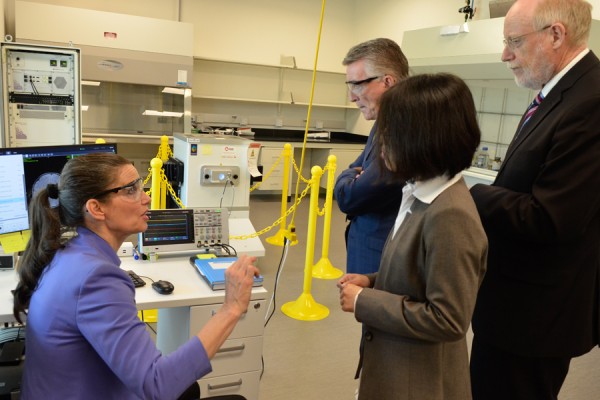 Federal science minister Kirsty Duncan asks questions of physics professor Dan Xiao during a tour of the Essex CORe facility with officials Douglas Kneale and Jeff Berryman.
Federal science minister Kirsty Duncan asks questions of physics professor Dan Xiao during a tour of the Essex CORe facility with officials Douglas Kneale and Jeff Berryman.
Kirsty Duncan, Canada’s minister of science and sport, joined interim UWindsor president Douglas Kneale and members of the campus community Wednesday for the official opening of the Essex Centre of Research (Essex CORe).
The 46,000 CORe Centre, which opened for use in December 2018 and is an addition to the existing Essex Hall, consists of three floors of open-concept lab space devoted to the following areas of research:
- Advanced materials, including nano-technology and biometrics;
- Transitional health, which brings discoveries from the laboratory to the bedside, with particular emphasis on cancer;
- Medical physics, including medical imagining and diagnostic technologies.
The project was announced in January 2017 during an event with UWindsor alumnus Navdeep Bains (MBA 2001), minister of innovation, science and economic development. It received $14.95 million in funding from the Government of Canada, $2.56 million from the province, and an addition commitment of $12.8 million from the University of Windsor.
“I’m honoured to be part of a government that is putting science and research front and centre,” said Minister Duncan. “This new, state-of-the-art energy-efficient science, research, and innovation facility is home to leading-edge research and development, which will create jobs in and around Windsor and help improve the lives of Canadians.”
Faculty of Science dean Chris Houser says the new spaces, dedicated to research, innovation, and industry collaboration, support both undergraduate and graduate research, which he calls “the most effective experience for students.”
In addition to research labs, the centre’s hub and meeting rooms are intended as collaborative spaces to advance research undertaken within and between academic and industrial partners.
“This facility is the outcome of a unique multilateral partnership at federal, provincial, and university levels,” said Dr. Kneale. “If I had to write out its equation for success, it would be: aesthetically stunning space + brilliant state-of-the-art functionality + human imaginativeness = unlimited research potential.”
